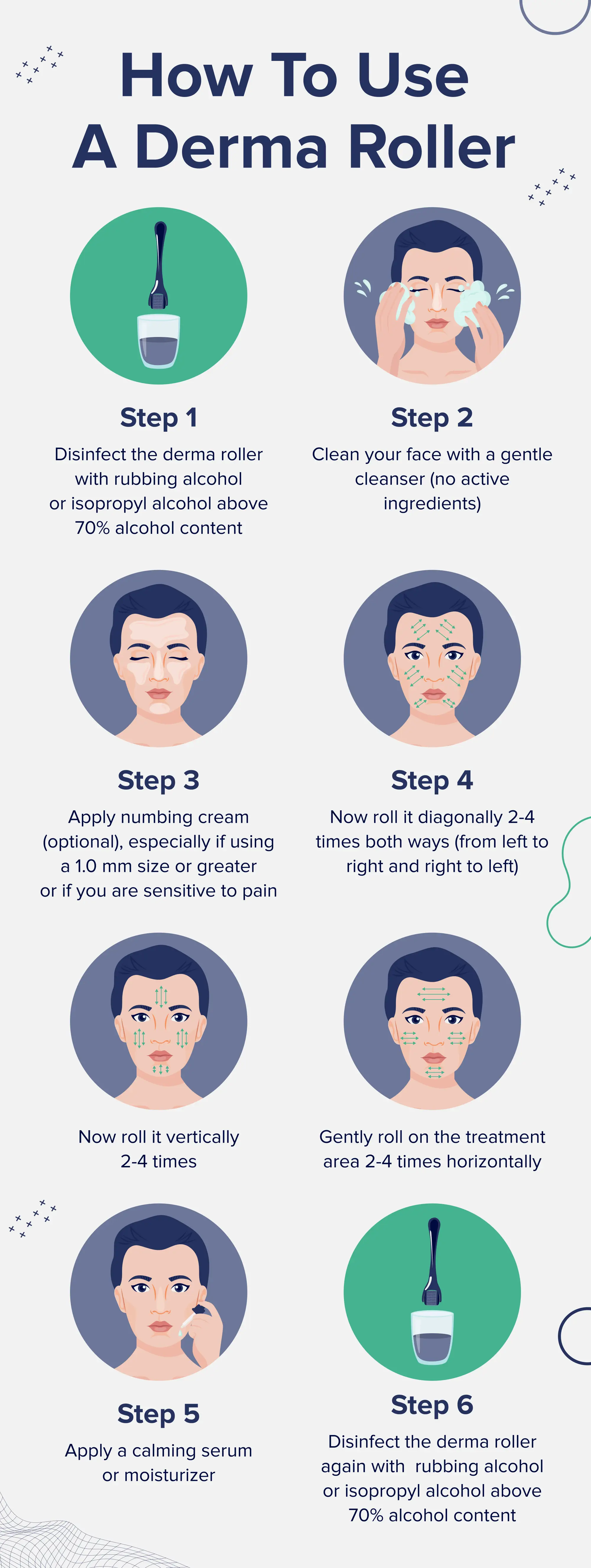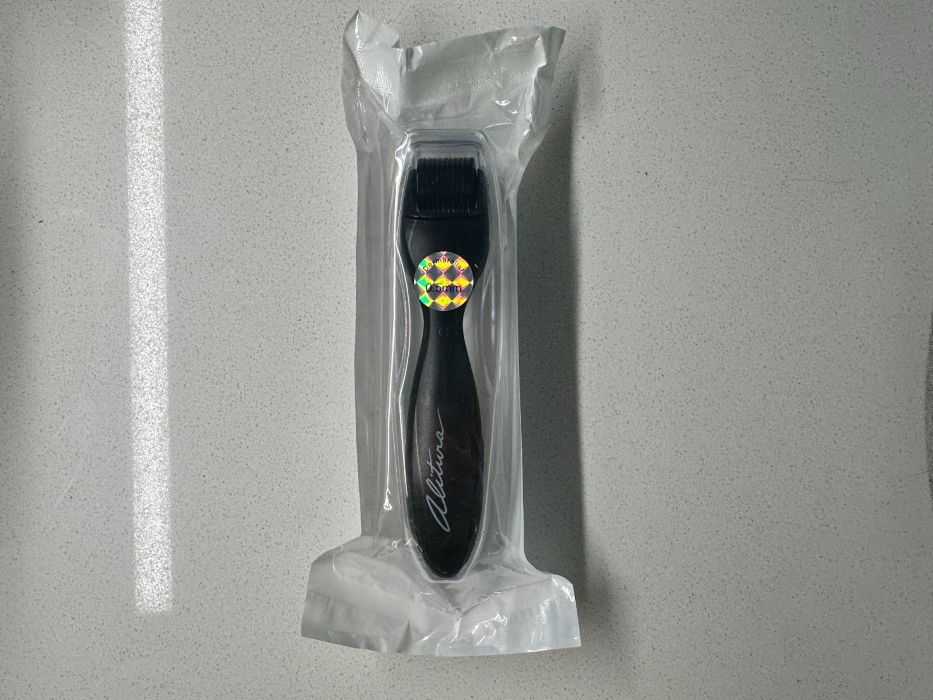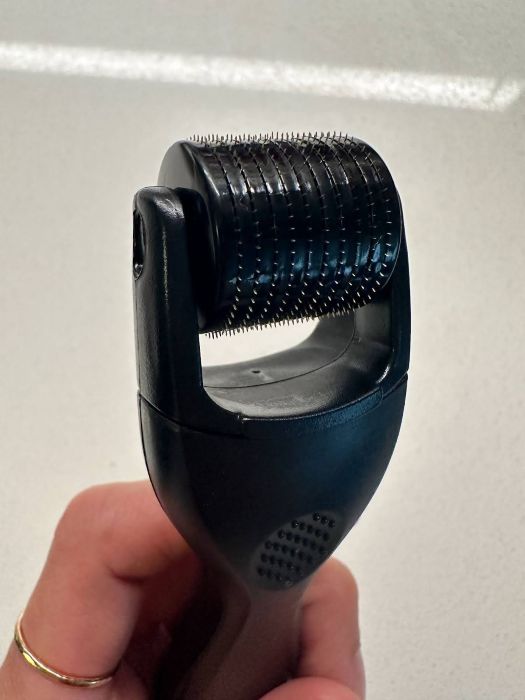Save $40 on your initial consult with a TNI Dietitian!
Talk to a real Dietitian for only $99: Schedule Now
This post contains links through which we may earn a small commission should you make a purchase from a brand. This in no way affects our ability to objectively critique the products and brands we review.
Evidence Based Research To fulfill our commitment to bringing our audience accurate and insightful content, our expert writers and medical reviewers rely on carefully curated research.
Read Our Editorial Policy
If you have acne scars, skin discoloration, or wrinkles, you may have come across microneedling in your quest for better skin. However, the price tag at the dermatologist’s office may have put you off.
Another less intense option is at-home microneedling, which typically uses a rolling device with tiny needles that create micro-tears in the skin to stimulate collagen production, heal scars, and facilitate blood flow.
While breaking the skin and drawing blood sounds a little alarming (the things we do for beauty, right?), microneedling or derma rolling is actually considered a minimally invasive procedure—especially if you do it at home with a small needle size, like one of the three offered by Alitura. In this review, I tested the Alitura Microneedle Derma Roller in three sizes and evaluated its quality, functionality, price, efficacy, and side effects—let’s get rolling.
I rated the Alitura Microneedle Derma Roller with an overall A (especially the 0.25mm size), with high points for its ease of use, different size options, and efficacy. I also liked that you can pop out the needle head to replace it with a different size or new roller, which minimizes waste.
Some cons (which would apply to all at-home derma rollers) include how easily damage your skin if you’re not careful and having to sterilize after each use. Specific to Alitura, I didn’t like that they didn’t provide any instructions about when to use each size or the differences between them.
Alitura was founded by Andy Hnilo after an intense accident (getting struck by a series of large vehicles while crossing the street) left him with severe facial scarring and a myriad of life-threatening injuries.
From this event, Andy wanted to create natural skincare products to heal his own facial scarring. Thus, Alitura (meaning to feed and nourish in Latin) was born.
He began with Alitura’s line of organic skincare creams and moisturizers made from ingredients sourced in Haleiwa, Hawaii. Microneedle derma rollers were introduced to further benefit facial scarring and collagen production.
The Alitura microneedle derma roller comes in three sizes:
How does it work? Essentially, derma rolling creates microscopic skin tears that stimulate collagen and elastin production, reducing the appearance of scars and fine lines.
The tiny needle penetrates the skin, where the minor injury triggers the release of beneficial growth factors like transforming growth factors alpha and beta (TGFα, TGFβ), fibroblast growth factor (FGF), and platelet-derived growth factor (PDGF), which improve skin health.
While derma rolling was originally only used in dermatologists’ offices, at-home microneedle face rollers like Alitura’s are now available at a fraction of the cost.
While risks are involved with at-home derma rolling (which we’ll discuss), Alitura makes it easy.

Before we get into the details about Alitura, let’s briefly discuss how to safely use a microneedle derma roller and the critical notes to consider before using one.
Step 1: Disinfect the derma roller with rubbing alcohol or isopropyl alcohol that contains a minimum of 70% alcohol.
Step 2: Clean your face with a gentle cleanser (no active ingredients).
Step 3 (Optional): Apply numbing cream (especially if using a 1.0mm size or greater or if you are sensitive to pain)
Step 4: Roll the derma roller back and forth using light to medium pressure on each area 2-4 times in four directions: horizontally, vertically, and diagonally (both ways) on any area needed. This can be done on the forehead, cheeks, chin, jaw, neck, and chest.
Step 5: Apply a calming serum or moisturizer.
Step 6: Disinfect the derma roller again with rubbing alcohol or isopropyl alcohol.
Important things to note:

In this section, I’ll go into the quality of the product (including packaging), how it works and its functionality, effectiveness, value, and side effects.
First, let’s review the packaging. The Alitura derma rollers come in sleek-looking black boxes and are individually sealed in sterile wrapping—like the kind you see doctors’ or dentists’ equipment coming in.


I like that each derma roller has its own case for when you’re not using it, which reduces the risk of bacteria or dirt settling in it.

Alitura derma rollers use CE-certified titanium needles, which do not rust and are stronger than stainless steel needles. Titanium is more durable, meaning the needles will last longer, and the sharpness won’t blunt as fast. However, stainless steel is more sterile, so you may need to disinfect titanium ones more often (as you should anyway). The needles are also not coated with a cylindrical shape and are aligned in straight rows for more even and precise microneedling.

One of my favorite things about this derma roller is that you can remove the heads (the part with the microneedles) to swap out a different needle size or when you need to replace it.

The handles are sturdy and conform to the typical shape of your hand and fingers, making it easy to use the roller on your face.
The Alitura derma rollers are extremely easy to use, even for beginners. As long as you follow the steps outlined above, you should have no trouble using the roller without any issues.
After having these rollers for about a month, I see no visible wear and tear or any concerns regarding the quality or functionality of the rollers—they still seem brand new.
How to use it is pretty straightforward. Simply cleanse your skin, then, with gentle pressure—not too light, not too hard—roll the microneedler across the desired area 2-4 times in an upward motion. Then, you’ll do 2-4 rolls each in horizontal and diagonal motions (both ways).
However, one thing I wish they had included in their instructions was when to use each size. They say that 0.25mm is for beginners, 0.5mm is for intermediates, and 1.0mm is for advanced, but it’s not very clear what that means. It would be more helpful if they explained who the different sizes are best for.
The Alitura microneedle derma roller is very reasonable compared to other ones on the market—especially when you compare it to dermatologist-based microneedling, which can cost up to $700 per session (but is understandably also much more effective).
Each size (0.25mm, 0.5mm, and 1.0mm) of this derma roller is the same price:
Let’s take a look at some other at-home microneedle rollers you can buy:
Granted, some of these more pricey derma rollers have higher-quality handles (not plastic), but I don’t think that something you use for ~30 seconds every other day (at the most) needs a rose quartz handle or anything fancy—but that’s just me!
If you want to display your derma roller proudly (although you really shouldn’t, as it could get dirt, dust, or bacteria), feel free to get a fancier one, but this one works fine for me.
Compared to microneedling done by a dermatologist, at-home microneedling takes longer to see results. I tested and reviewed the 0.25mm derma roller for about two weeks and can say I see minor improvements already. However, it takes time for discoloration, scarring, and wrinkles to improve significantly.
I have less experience with the other two sizes, 0.5mm and 1.0mm, as you should wait 4-5 days and 7-10 days between using each of them to allow your skin to recover. Based on my first thoughts and about three weeks of testing the Alitura derma roller in various sizes, I have confidence that they will be effective in helping with post-inflammatory hyperpigmentation (PIH) and fine lines. For more details, head down to the “My Experience” section.
There are many potential side effects with the Alituria derma roller (as with any microneedle-based derma roller). However, these typically only occur if you use it incorrectly.
If you use the derma roller on active acne or infections, you will almost certainly spread the infection to the rest of your face, causing acne or other infections in those areas.
If you press too hard with the roller, you can injure your skin and cause scarring or long-lasting damage to your skin barrier. Similarly, the same effects can happen if you use it too frequently. Longer needles require more recovery time than shorter ones. You can typically use a 0.25mm needle every other day or, in some cases, even daily.
In a systematic review published in the Journal of Clinical and Aesthetic Dermatology, researchers combined data from 51 studies. They concluded that microneedling with any device (at-home or professional) was found to be “a relatively safe procedure with minimal adverse effects, including, but not limited to, expected erythema [redness], pain, edema, and temporary skin irritation.”
Overall, I really like using the Alitura microneedle derma roller—especially the 0.25mm size. As they were very different experiences, I’ll review each size separately.

This is the smallest-size microneedle, recommended for post-inflammatory hyperpigmentation (PIH, the brown or red discoloration that remains after injuries or breakouts), fine lines, enlarged pores, and other skin discolorations.
I used the 0.25mm roller every other day for about two weeks on my forehead and cheeks, areas where I have fine lines, uneven texture, and PIH. After these two weeks, I saw some minor improvements in all areas. However, as this is the smallest size (much smaller than you would use in a dermatologist’s office), it can take many months to see significant results.
Regarding pain, using the 0.25mm microneedle was not painful to me at all—it just felt like little pricks but did not hurt or draw blood.
As noted previously, you absolutely cannot use your derma roller on active acne. Doing so will spread the bacteria to other areas of your face and can cause infection. Therefore, I was very careful to limit the derma rolling to breakout-free zones.
The 0.5mm size is often recommended for more severe PIH, moderate acne scars (including pocked scars), enlarged pores, sun-damaged skin, and uneven skin texture.
I expected this size to hurt a bit more than the 0.25mm, which was accurate. As I have a pretty high pain tolerance, I don’t think it hurt a ton, but it definitely stung more than the 0.25mm size. It also produced more redness and lingering pain (the sting was still there about 20 minutes after using it).
I’ve only used this size twice so far, as it’s recommended to space out the use to just twice a week.
Going much deeper into the skin than the other sizes, the 1.0mm derma roller is more intense, and its uses include improving severe acne scars (like ice pick scars), sun-damaged skin, stretch marks, and surgical scars.
Based on opinions I read from dermatologists that said you really shouldn’t be using this size untrained at home, I was honestly a bit hesitant to use it. However, I did take one for the team and used it once (without a numbing cream, which I did not have), but I was pleasantly surprised with the lack of pain.
Well, there wasn’t no pain, but I expected much more. The 1.0mm size hurt a bit more than the 0.5mm size and produced more redness and lingering pain, but it did not draw any blood. Like with the 0.5mm size, a slight stinging discomfort remained for about 20 minutes after using it, as did the redness.
As the 1.0mm size is only advised to be used once every 10-14 days, I still need to gain more firsthand experience with this size.
Overall, the Alitura derma roller is effective, easy to use, and made of high-quality materials. I recommend the 0.25mm Alitura derma roller for beginners and people with low pain tolerance, but the 0.5mm is fine for most people when you feel ready to step things up a notch. If you have a low pain tolerance, I would probably advise against using the 1mm size unless you have a numbing cream.
Microneedling uses thousands of tiny needles to create microtears in your skin. While this doesn’t sound great, these small tears can help your skin to heal and repair itself. Microneedling can boost collagen production, which helps to reduce scarring, hyperpigmentation, skin aging, and wrinkles or fine lines. It can also reduce the appearance of large pores and increase the absorption of serums and moisturizers.
If done correctly, at-home microneedling is safe and effective. Start with the smallest microneedle size (0.25mm) to see how your skin does, and move up from there. You should not use a needle size of over 1.5mm at home—that should solely be done by a dermatologist. Depending on their skin type and sensitivity, some people probably should not even use 1.0mm. If you have active acne or infections, never use your microneedle roller on that part of your face, as it will spread the infections around. Be sure to disinfect your derma roller after each use.
At a dermatology office, microneedling will probably hurt, as they use more intense needles than at home. However, they can provide you with a numbing cream. At home, hurting depends on how sensitive your skin is and your pain tolerance. In my experience, 0.25mm does not hurt at all and feels like painless pricks. The 0.5mm and 1.0mm needles hurt very slightly, cause some redness, and leave lingering light pain for about 20 minutes.
It depends on your pain tolerance and skin goals. Typically, starting with a 0.25mm microneedle is recommended for post-inflammatory hyperpigmentation (PIH, the brown or red discoloration that remains after injuries or breakouts), fine lines, enlarged pores, and other skin discolorations. You should also use 0.25mm if you are a first-timer with microneedling. After using the 0.25mm for a while, you can move up to 0.5mm if you’re not seeing any results with the previously mentioned conditions. The 0.5mm size is also good for more severe PIH, moderate acne scars (including pocked scars), enlarged pores, sun-damaged skin, and uneven skin texture. The 1.0mm size is more intense, and its uses include improving severe acne scars (like ice pick scars), sun-damaged skin, stretch marks, and surgical scars. Any higher than 1.0mm, and you might want to go into a dermatologist’s office—don’t try it at home!